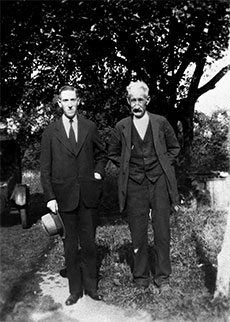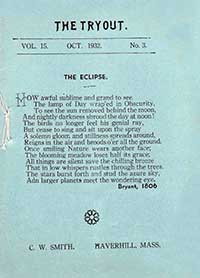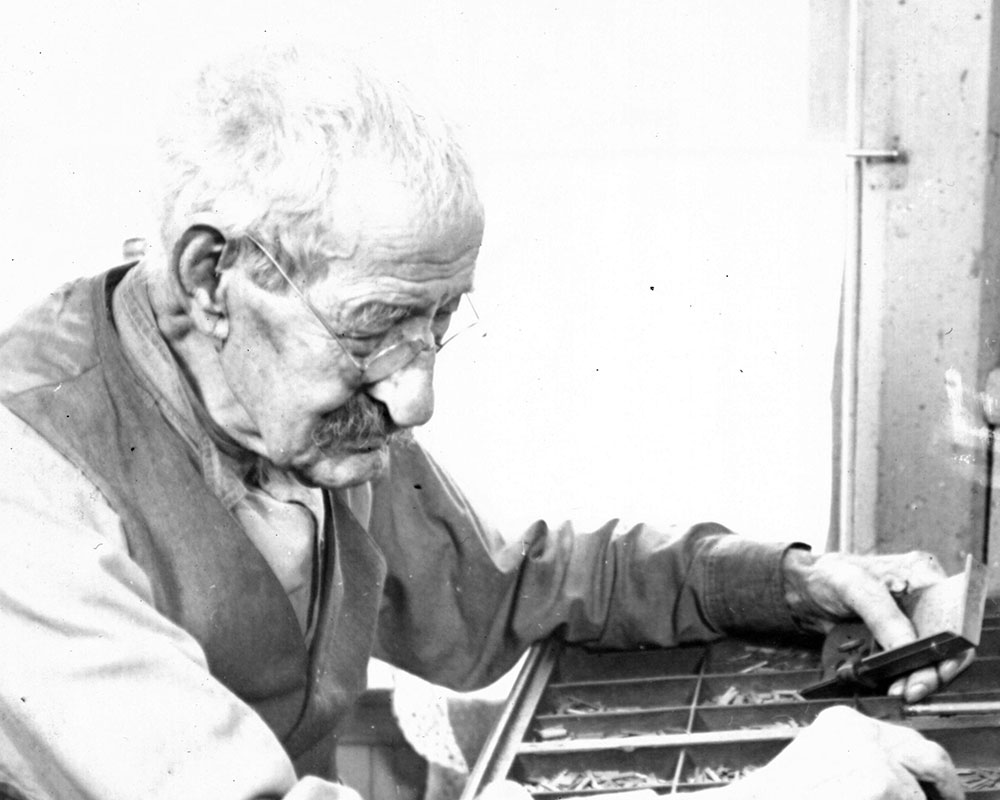By David Goudsward
Special to Wavelengths

Tryout Smith and Lovecraft facing Water Street. The tip of Hales Island in the Merrimack is visible behind them, October, 1931.
On June 9, 1921, retired small business owner Charles W. Smith received a visitor at his home on Haverhill’s Groveland Street. Smith was the internationally known and respected elder statesman of the amateur press movement and the publisher of The Tryout.
Amateur journals—small magazines, hand set type, printed by hand, collated and bound by hand—were mailed for free to other amateur journalists. His visitor was a long-time correspondent, officer of a national amateur press organization and a regular contributor to amateur journals, legendary for his critiques of fellow amateur writers and poets. His name was Howard Phillips Lovecraft.
Charles William Smith was born in Haverhill on October 24, 1852. As a teenager, he was fascinated with typesetting and acquired a small hand press to experiment with on his own. Although he was being paid to print calling cards and other small jobs for friends, even as a teen, Smith considered it a hobby.
Smith attended Haverhill schools, dropping out at 13 to work in a factory as a stock clerk, not unusual for the times. His father began working in a local sawmill, and Charles and his brother Frank soon joined their father manufacturing wooden boxes for the shoe industry at the John Green Box Company on Fleet Street.
After his marriage to Ida Boynton, Smith lived with his parents on Auburn Street until after the birth of his children. His wife died in 1885, leaving Smith with two preteen daughters. He returned to Auburn Street so that his widowed mother could help to raise his daughters.
In 1885, Haverhill was the Queen Slipper City, with five daily newspapers to suit any political inclination from the Daily Laborer (social labor) to the Haverhill Gazette (conservative). It was also home to the largest amateur press club of New England outside of Boston, with two monthly journals, Haverhill Life and Pick Me Up. Ironically, in the midst of this publishing, Charles Smith had already ended his involvement in amateur publishing after his marriage. He had already published three different journals, two simultaneously (one humorous and one general interest).
In 1888, Charles’s brother Frank became too ill to work, so Smith returned to his childhood hobby of printing to help Frank save some money coming in. The brothers began publishing the Monthly Visitor, a widely circulated amateur publication that started during December, 1888. and ran for 118 issues—the last issue coming off the press in October, 1898. Charles knew going into the project it was never going to be a money-making operation, but it allowed Frank, as his health permitted, look for advertisers while Charles ran the press.
Charles had worked his way up to foreman at the box company, eventually buying the company in 1897 from the retiring owner and renaming it the C. W. Smith Box Company. Located across the street from the back of Haverhill City Hall on Main Street, Smith expanded the business to sell the sawdust created in the box-making operation. Smith’s business acumen, or at least his timing, was suspect at best. His purchase of the box company coincided with the introduction of less expensive cardboard boxes, and the wooden box industry began to decline.
The Monthly Visitor ceased publication in 1889 when Tryout discovered owning his business left no time for amateur journalism. In 1899, Smith’s box factory suffered a two-alarm blaze that gutted the building. The fires started in an adjoining building but quickly spread to his three-story wooden structure, which was filled with dry wood and sawdust. The conflagration’s intensity and proximity to the City Hall undoubtedly raised the specter of the Great Fire of 1882, which had leveled the downtown shoe manufacturing district. The Boston Daily Globe noted the mill had been the site of four major fires and the neighborhood of aging wooden industrial structures were among the most dangerous buildings in the city.
Smith sold the company, retired and moved in with his daughter and son-in-law on Groveland Street. With one brief exception, he would live there uninterruptedly from 1904 until his death.
Smith Returns to Amateur Publishing with ‘Tryout’

1932 issue of The Tryout.
After a decade of retirement, the boredom became too much. He dusted off his press and re-entered the world of amateur journalism. The first issue of the Tryout was published in 1914 from a shed in the yard on Groveland Street. At the time, Smith was 62 years old, mostly deaf from his years in the mill and further hindered with such poor vision that typesetting became somewhat of an adventure. The name Tryout was selected because he wasn’t sure if he could see well enough to operate the press, so he thought he’d try it out. Smith gave the press an extended try out, hand-setting the type for 300 issues from 1914 to 1944.
The Tryout was legendary for its typographical errors, which infuriated contributors unaware of Smith’s age and infirmities. Lovecraft, who gave Smith the nickname “Tryout Smith,” was occasionally vexed by the errors but sympathetic as to the reason for them, quaintly referred to them as “tryoutisms.” Most of Lovecraft’s poetry first appeared in the Tryout, and he became such a prolific contributor that he and Smith began publishing some of his work under pseudonyms just to avoid the appearance of Lovecraft monopolizing the pages.
When Smith’s health declined in later years, the press was moved into the house, but by then the shed had been immortalized in Lovecraft’s correspondence. In a letter to fellow amateur journalist Rheinhart Kleiner in 1921, Lovecraft described his first visit to Smith’s shed as “a veritable curiosity shop, with all the odds and ends of forty years hung or strewn about. There are buttons, stamps, chromos, and dingy photographs on the walls, and in various corners sundry odd iron objects—a miniature anvil, for instance—washed in by the tides of the neighbouring Merrimack.” The shed was demolished by a subsequent owner; the house was destroyed in a 1998 fire.
Tryout Smith churned out issues like clockwork until his health became too frail. The final issue was August, 1944, ending the Tryout’s 30-year run. Charles W. “Tryout” Smith died on February 17, 1948, at the age of 95 and was buried in Haverhill’s Hilldale Cemetery in a family plot.
Tryout Smith’s legacy was far beyond that of the venerable amateur pressman. Amateur journals in general publication served as an incubator that encouraged new writers by disseminating their work, offering criticism and creating a support system for novice writers. The Tryout in particular was successful in encouraging new talent. Among the fledgling writers that gained confidence in the pages of the Tryout were H.P. Lovecraft, publisher/writer; August Derleth, curator; freethinker James Morton; novelist Edith Miniter; philatelic expert/editor Willard O. Wylie; syndicated children’s author Myrta Little Davies; anthropologist R.H. Barlow; regional humorist W. Paul Cook; and many more. Thanks to Lovecraft’s massive correspondence being published, today the address of the elderly ink-stained sage of 408 Groveland Street in Haverhill is as well known as the address of any literary figure.
David Goudsward, raised on the summit of Scotland Hill, brings his New England sensibilities and respect for historical perspective his work. Although living in Florida, his bibliography consists primarily of New England topics. His latest book, “H.P. Lovecraft in the Merrimack Valley,” discusses “Tryout” Smith in more depth and is available via Amazon. He is WHAV’s Open Mike Show’s historian.

